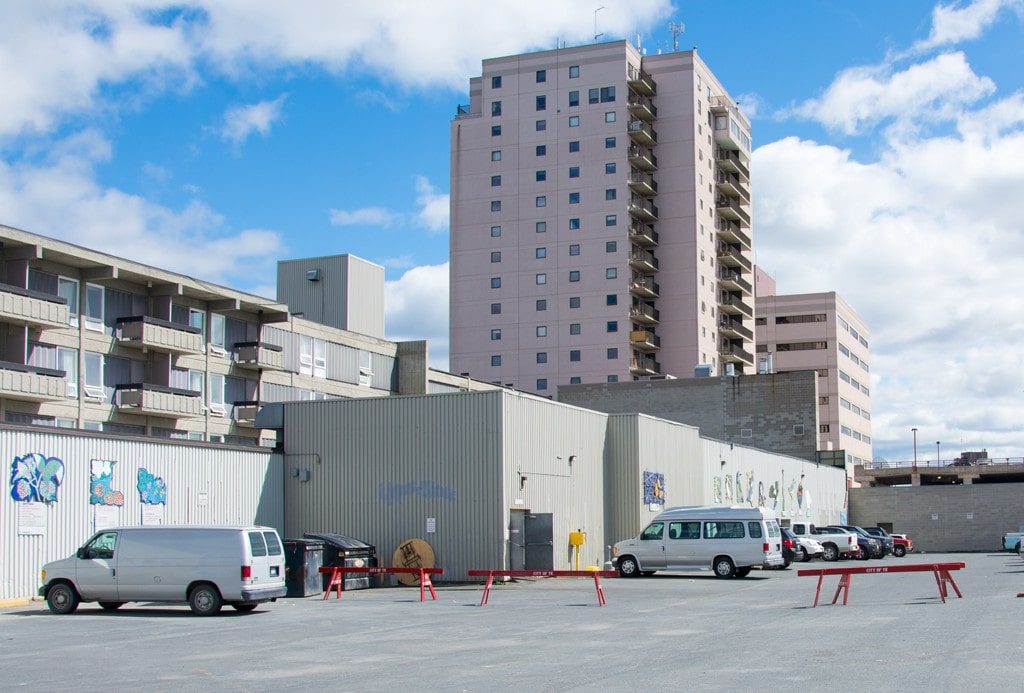Just over a year ago, the Yellowknife Chamber of Commerce released the results of a survey which asked their members if they supported Business Improvement Districts — essentially a scheme in which businesses pay into a fund for collective revitalization and promotion efforts. The results were stark: 50 percent of respondents opposed the idea, another 23 percent weren’t sure.
The survey wasn’t without problems: only 15 percent of people who got the survey filled it out, and the results didn’t specify whether or not the respondents were downtown business owners, i.e. people who would actually be affected by a BID, for better or for worse.
Still, with such apparent opposition from Yellowknife’s business community — not the first time they’ve opposed BIDs — it was interesting to see this week that City Hall is still pushing the idea.
The most attention-getting idea is to hire law enforcement officers to focus specifically on downtown. This could take the form of either MED officers with expanded powers, RCMP officers contracted by the City, or even some kind of community constables.
Perhaps “pushing” is too strong a word. But on Wednesday evening, a City-organized event was (aptly) held in the vacated Diavik Offices, where four local business people who’d attended a BID conference in Vancouver courtesy of the City gave presentations on what they’d learned there about downtown revitalization.
With no offence intended to the presenters, their delivered insights were expected platitudes: to revitalize downtowns there needs to be a focus on improving security, public festivals, more arts, better “wayfinding” through public space, pedestrian-centred design, and so on.
All of these things are good ideas — but the speeches resembled class presentations after a field trip rather than an attempt to start a movement of progressive downtown business owners keen to kickstart a BID and bring their doubting compatriots into line. This was confirmed afterwards in conversation with two of the presenters, who, like most people in the room, thought BIDs were a good idea, but didn’t really think now was the right time.
Even Adrian Bell, the city councillor who’s been pushing the BID agenda for the last few years, is now expressing serious reservations.
“Business improvement districts have had such a history of success in other communities, that it’s pretty easy to look at it as a potential solution here,” he said after the presentation. “I’m not going to say I’m against business improvement districts at this time, I’m just concerned that it might not work.
“In a lot of cities where these things have succeeded, they’ve got a business community in the downtown that’s standing on its own two feet and is prepared to come out to meetings, and do some volunteering, get active, vote — pretty much like the people you heard speak tonight, but a lot more of them,” he said. “I think [business owners in Yellowknife] are so distraught, they probably don’t believe it’s going to make a difference and so they probably won’t support the creation of a business improvement district… If there were more thriving businesses in our downtown, that would be a different story.”
What then, if not BIDs? As Coun. Julian Morse put it, “The downtown is not going to revitalize itself.”
A clean and safe wish list
Even as the bid for BIDs loses steam amongst council, two of the councillors EDGE spoke to at the event said they’re pushing for a more City Hall-centric approach, but focusing mostly on the “clean and safe” aspect of the revitalization.
“Before we start talking about multimillion-dollar parks in a downtown that many perceive as being not clean and safe, obviously we need to work on that first,” says Bell.
A number of items have been added to next year’s budget wish list, to be debated in the fall. The most attention-getting idea is to hire law enforcement officers to focus specifically on downtown. This could take the form of either MED officers with expanded powers, RCMP officers contracted by the City, or even some kind of community constables.
Attention-getting, but a challenging step for the City to take; as Morse puts it: “We’re already expanding the mandate of the City into social issues with the housing first program. If we start to get into policing, I think the question is how far out of our mandate are we going to go because the GNWT isn’t providing adequate resources for their mandate.
“But then you look at the municipalities. A lot do have police forces,” Morse continued, “The difference from the territorial [funded police] is we can direct the mandate of that police force, so we can say, ‘look, the whole purpose of this police force is to make the downtown a safer space.’”
Other ideas added to the budget wish list include more funding towards the day shelter to extend its hours of operation so there are no gaps in the morning and evening when neither the day shelter or the overnight shelter are open. Then there’s the possibility of funding an employment coordinator to operate out of the day shelter, connecting clients with business owners who need short-term jobs like street cleaning or snow shovelling.
It may prove difficult to push these downtown-centric proposals through the budget process. For one, they won’t be cheap, and for several years now, some councillors have been fuelling the unrealistic expectation that you can always achieve a zero percent tax increase. And it may be tough to convince folks in the suburbs that, in Bell’s words, “as goes the downtown, so goes the community.” That’s the beauty of a BID after all: they’re essentially taxes raised by a small pocket of the community for use by that same small pocket of the community.
Expense aside, the growing consensus among many Yellowknifers that the city and its downtown are in a state of genuine crisis may make it easier to win people over to a “clean and safe” agenda — as slightly ominous as that sounds — than to the grander visions of libraries and plazas that have been swirling around. Bell again: “We talk about legacy infrastructure, things like university facilities, or post-secondary down the road, or even recreational facilities or a library. Those types of things are not going to start this process — they’re further down the road. If we want to attract them, what we need to do is attract the coffee shops, the shoe stores, the bakery… [To do that] we need to make it safe and clean, and we think the business will follow.”
Not entirely dead yet
Should serious investments be made by the GNWT and City Hall in the Yellowknife’s downtown — which looks reasonably promising with the new budget wishlist from council, the Housing First RFP moving forward, and the $600,000 from the GNWT for shelter renovations — the BID idea could yet see a revival.
“I do believe this has a role to play. I just don’t think this is in year one of the 15 year plan. I think it’s more in year five,” says Bell.
It comes down to how skittish the business community is at a given time, and how well the idea is pitched. As developer Robert Warburton, who presented at the City event, put it:
“How [the Chamber of Commerce’s BID] conversation was framed was, ‘Do you want to spend more money?’ I don’t think that’s the right way to frame it. As a property owner I’d be happy to pay a bit more money if I knew every penny of that wasn’t going into a general tax pool, every penny of that is going into improving things directly around my property or business. It’s different.”
“If there’s a real benefit I can see from my front door — there’s street cleaners every day, there’s benches, there’s events happening — I think it will be a hard sell on the front end, but I think people will see the benefits.”







